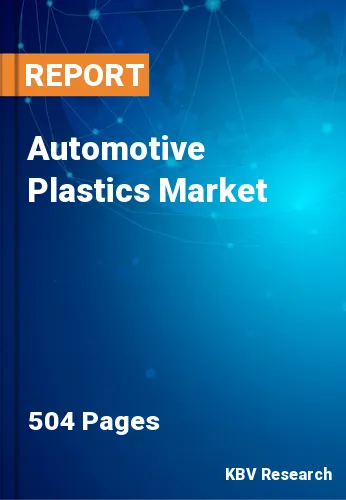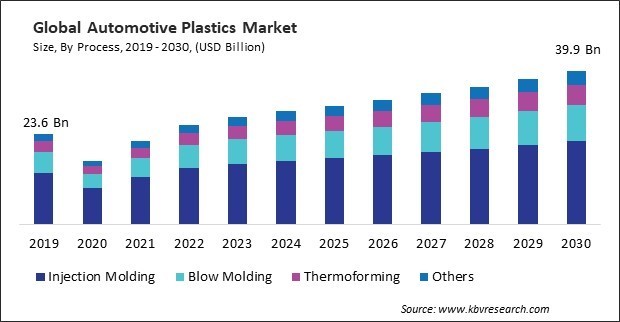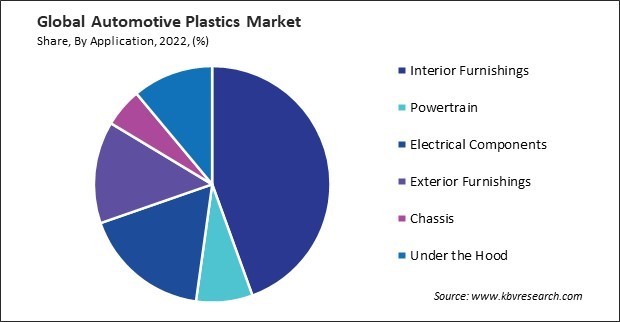
The Global Automotive Plastics Market size is expected to reach $39.9 billion by 2030, rising at a market growth of 5.1% CAGR during the forecast period. In the year 2022, the market attained a volume of 14,844.4 Kilo Tonnes, experiencing a growth of 3.4 % (2019-2022).
Plastics increasingly find applications in exhaust system components, including mufflers and heat shields. Certain high-temperature-resistant plastics contribute to the thermal management of the exhaust system. Therefore, the powertrain segment captured $2,017.0 million revenue in the market in 2022. Plastics are used in fuel system components, including fuel tanks, lines, and rail components. Plastics offer corrosion resistance and can withstand the chemical properties of fuels, contributing to the durability and safety of the fuel system. The shift toward electric powertrains, including hybrid and fully electric vehicles, has increased the use of plastics in components such as electric motor housings, battery casings, and power electronics enclosures. Plastics contribute to weight reduction and insulation in these electric powertrain components.

These plastics are used in safety-critical components that contribute to crashworthiness and occupant safety. Plastics provide impact resistance and can be engineered to absorb energy during collisions, enhancing overall vehicle safety. Plastics are used to manufacture impact-resistant exterior components, such as bumpers, fenders, and side panels. These components are designed to absorb and distribute impact energy, minimizing damage to the vehicle and enhancing pedestrian safety. Additionally, growing environmental awareness and sustainability considerations drive the adoption of recyclable and eco-friendly materials. These plastics can be derived from renewable resources and may break down more easily in certain disposal environments, contributing to overall sustainability. Programs and initiatives focused on end-of-life vehicle recycling promote the responsible disposal of these plastics. These programs aim to recover and recycle materials from decommissioned vehicles, diverting plastic waste from landfills and incineration. Thus, because of the expansion of recyclability and sustainability, the market is anticipated to increase significantly.
However, Compliance with stringent regulations often requires additional testing, certification, and quality control measures. This can lead to increased production costs, impacting the overall cost-effectiveness of these plastics and potentially slowing down market growth. Failure to fulfill regulatory standards can result in recalls, which incur major financial consequences for producers and destroy consumer trust in the brand. Regulatory compliance often intersects with sustainability goals. If compliance issues arise, it may hinder the automotive industry's progress toward achieving environmental targets related to emissions, recyclability, and overall sustainability. Stringent regulations may lead to a conservative approach in material selection, with manufacturers opting for well-established materials to ensure compliance. This resistance to adopting advanced materials can hinder innovation in the market.
 Drivers
Drivers  Restraints
Restraints  Opportunities
Opportunities  Challenges
Challenges By process, the market is segmented into injection molding, blow molding, thermoforming, and others. In 2022, the injection molding segment registered the maximum revenue share in the market. Injection molding facilitates the fabrication of intricately designed and multifaceted geometries, encompassing varying thicknesses, undercuts, and intricate details. This skill is critical for producing complex automotive components with tight tolerances. Many thermosetting and thermoplastic materials can be used with injection molding. Injection molding is well-suited for high-volume production, making it an ideal process for meeting the mass production requirements of the automotive industry. The ability to produce many parts relatively quickly enhances production efficiency.
On the basis of application, the market is divided into powertrain, electrical components, interior furnishings, exterior furnishings, under the hood, and chassis. The electrical components segment recorded a remarkable revenue share in the market in 2022. Plastics play a crucial role in manufacturing connectors and housings for electrical components. They provide electrical insulation and protection against moisture and contaminants and contribute to the overall reliability of electrical connections. Plastics are utilized in power distribution systems, including fuse boxes and distribution panels. Plastics are used for housing and protecting various sensors throughout the vehicle, including those for engine control, safety systems, and driver assistance. Plastics offer electrical insulation and protect sensors from environmental elements.

By product, the market is categorized into polypropylene (PP), polyurethane (PU), polyvinyl chloride (PVC), polyamide (PA), acrylonitrile butadiene Styrene (ABS), high density polyethylene (HDPE), polycarbonate (PC), polybutylene terephthalate (PBT), polyethylene (PE), polymethyl methacrylate (PMMA), and others. In 2022, the polypropylene (PP) segment held the highest revenue share in the market. Polypropylene is chemically resistant to various substances, including automotive fluids. Polypropylene is recyclable, contributing to sustainability efforts in the automotive industry. The capacity for polypropylene materials to be recycled and reused is consistent with the increasing focus on environmentally friendly manufacturing methods.
Free Valuable Insights: Global Automotive Plastics Market size to reach USD 39.9 Billion by 2030
Region-wise, the market is analysed across North America, Europe, Asia Pacific, and LAMEA. In 2022, the Asia Pacific region led the market by generating the highest revenue share. The Asia Pacific region is a key automotive production hub, with many leading global automakers having manufacturing facilities in China, Japan, South Korea, and India. Electric and hybrid vehicles are rising rapidly throughout the Asia-Pacific region. Automotive manufacturers in the Asia Pacific prioritize lightweight to enhance fuel efficiency and overall vehicle performance. Consumers in the Asia Pacific region increasingly seek vehicles with advanced features, connectivity options, and smart interiors.
| Report Attribute | Details |
|---|---|
| Market size value in 2022 | USD 26.1 Billion |
| Market size forecast in 2030 | USD 39.9 Billion |
| Base Year | 2022 |
| Historical Period | 2019 to 2021 |
| Forecast Period | 2023 to 2030 |
| Revenue Growth Rate | CAGR of 5.1% from 2023 to 2030 |
| Number of Pages | 504 |
| Number of Table | 890 |
| Quantitative Data | Volume in Kilo Tonnes, Revenue in USD Million, and CAGR from 2019 to 2030 |
| Report coverage | Market Trends, Revenue Estimation and Forecast, Segmentation Analysis, Regional and Country Breakdown, Porter’s 5 Forces Analysis, Company Profiling, Companies Strategic Developments, SWOT Analysis, Winning Imperatives |
| Segments covered | Product, Process, Application, Region |
| Country scope |
|
| Companies Included | BASF SE, SABIC (Saudi Arabian Oil Company), LyondellBasell Industries Holdings B.V., LG Chem Ltd. (LG Corporation), Borealis AG (OMV), Arkema S.A., DuPont de Nemours, Inc., The Dow Chemical Company, Covestro AG and Evonik Industries AG (RAG-Stiftung) |
By Process (Volume, Kilo Tonnes, USD Billion, 2019-2030)
By Application (Volume, Kilo Tonnes, USD Billion, 2019-2030)
By Product (Volume, Kilo Tonnes, USD Billion, 2019-2030)
By Geography (Volume, Kilo Tonnes, USD Billion, 2019-2030)
The Market size is projected to reach USD $39.9 billion by 2030.
Expansion of recyclability and sustainability are driving the Market in coming years, however,Significant regulatory compliance issues restraints the growth of the Market.
BASF SE, SABIC (Saudi Arabian Oil Company), LyondellBasell Industries Holdings B.V., LG Chem Ltd. (LG Corporation), Borealis AG (OMV), Arkema S.A., DuPont de Nemours, Inc., The Dow Chemical Company, Covestro AG and Evonik Industries AG (RAG-Stiftung)
In the year 2022, the market attained a volume of 14,844.4 Kilo Tonnes, experiencing a growth of 3.4 % (2019-2022).
The Interior Furnishings segment is leading the Market by Application in 2022; thereby, achieving a market value of $16.4 billion by 2030.
The Asia Pacific market dominated the Market by Region in 2022, and would continue to be a dominant market till 2030; thereby, achieving a market value of $18.8 billion by 2030.
Our team of dedicated experts can provide you with attractive expansion opportunities for your business.
